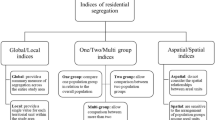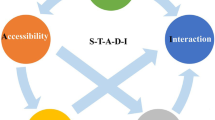Abstract
While the literature clearly acknowledges that individuals may experience different levels of segregation across their various socio-geographical spaces, most measures of segregation are intended to be used in the residential space. Using spatially aggregated data to evaluate segregation in the residential space has been the norm and thus individual’s segregation experiences in other socio-geographical spaces are often de-emphasized or ignored. This paper attempts to provide a more comprehensive approach in evaluating segregation beyond the residential space. The entire activity spaces of individuals are taken into account with individuals serving as the building blocks of the analysis. The measurement principle is based upon the exposure dimension of segregation. The proposed measure reflects the exposure of individuals of a referenced group in a neighborhood to the populations of other groups that are found within the activity spaces of individuals in the referenced group. Using the travel diary data collected from the tri-county area in southeast Florida and the imputed racial–ethnic data, this paper demonstrates how the proposed segregation measurement approach goes beyond just measuring population distribution patterns in the residential space and can provide a more comprehensive evaluation of segregation by considering various socio-geographical spaces.




Similar content being viewed by others
References
Abler R, Adams JS, Gould P (1971) Spatial organization: the geographer’s view of the world. Prentice Hall, London
Abramson AJ, Tobin MS, VanderGoot MR (1995) The changing geography of metropolitan opportunity: the segregation of the poor in United States metropolitan areas, 1970 to 1990. Hous Policy Debate 6:45–72
Beckmann MJ, Golob TF, Zahavi Y (1983a) Travel probability fields and urban spatial structure: 1. Theory. Environ Plan A 15:593–606
Beckmann MJ, Golob TF, Zahavi Y (1983b) Travel probability fields and urban spatial structure: 2. Empirical tests. Environ Plan A 15:727–738
Blair SL, Lichter DT (1991) Measuring the division of household labor: gender segregation of household among American couples. J Fam Issues 12(1):81–113
Blumen O, Zamir I (2001) Two social environments in a working day: occupation and spatial segregation in metropolitan Tel Aviv. Environ Plan A 33:1765–1784
Bowen WM, Salling MJ, Haynes KE, Cyran EJ (1995) Toward environmental justice: spatial equity in Ohio and Cleveland. Ann Assoc Am Geogr 85(4):641–663
Brown LA, Chung S-Y (2006) Spatial segregation, segregation indices and the geographical perspective. Popul Space Place 12(2):125–143
Brown LA, Moore EG (1970) The intra-urban migration process: a perspective. Geogr Ann Ser B 52(1):1–13
Buliung RN, Kanaroglou PS (2006) A GIS toolkit for exploring geographies of household activity/travel behavior. J Transp Geogr 14:35–51
Buliung RN, Remmel TK (2008) Open source, spatial analysis, and activity-travel behavior research: capabilities of the aspace package. J Geograph Syst 10:191–216
Corradino CS (2000a) Southeast Florida regional travel characteristics study: executive summary. Report prepared for Florida Department of Transportation, Districts IV and VI, Miami-Dade MPO, Broward County MPO, and Palm Beach County MPO
Corradino CS (2000b) Southeast Florida regional travel characteristics study: household travel characteristics survey plan and findings. Report prepared for Florida Department of Transportation, Districts IV and VI, Miami-Dade MPO, Broward County MPO, and Palm Beach County MPO
Cromley EK, McLafferty SL (2002) GIS and public health. Guilford Press, New York
Dawkins CJ (2004) Measuring the spatial pattern of residential segregation. Urban Stud 41:833–851
Deutsch J, Fluckiger Y, Silber J (1994) Measuring occupational segregation. J Econom 61:133–146
DuBois WEB (1934) Segregation. In: Weinberg M (ed) W.E.B. DuBois: a reader. Harper, New York, 1970
Ellis M, Wright R, Parks V (2004) Work together, live apart? Geographies of racial ethnic segregation at home and at work. Ann Assoc Am Geogr 94(3):620–637
Estlund C (2003) Working together: how workplace bonds strengthen a diverse democracy. Oxford University Press, New York
Feitosa FF, Camara G, Monteiro AMV, Koschitzki T, Silva MPS (2007) Global and local spatial indices of urban segregation. Int J Geogr Inf Sci 21:299–323
Galster GC, Killen SP (1995) The geography of metropolitan opportunity: a reconnaissance and conceptual framework. Hous Policy Debate 6:7–43
Golledge RG, Stimson RJ (1997) Spatial behavior: a geographic perspective. Guilford Press, New York
Goodchild MF, Janelle DG (1984) The city around the clock: space-time patterns of urban ecological structure. Environ Plan A 16:807–820
Grady SC (2006) Racial disparities in low birth weight and the contribution of residential segregation. Soc Sci Med 63(12):3013–3019
Grady SC, McLafferty S (2007) Segregation, nativity, and health: reproductive health inequalities for immigrant and native-born black women in New York City. Urban Geogr 28(4):377–397
Groves FD, Andrews PA, Chen VW, Fontham ET, Correa P (1996) Is there a ‘cancer corridor’ in Louisiana? J La State Med Soc 148(4):155–165
Guo JY, Bhat CR (2007) Population synthesis for microsimulating travel behavior. Transportation Research Record: Journal of the Transportation Research Board, No. 2014
Hägerstrand T (1970) What about people in regional science? Pap Reg Sci Assoc 24:7–21
Horton FE, Reynolds DR (1971) Effects of urban spatial structure on individual behavior. Econ Geogr 47(1):36–48
Janelle DG, Hodge DC (eds) (2000) Information, place, and cyberspace: issues in accessibility. Springer, Berlin
Kellerman A (1981) Centrographic measures in geography: concepts and techniques in modern geography (CATMOG) No. 32. Geo Books, University of East Angolia, Norwich
Kwan MP (1998) Space–time and integral measures of individual accessibility: a comparative analysis using a point-based framework. Geogr Anal 30(3):191–216
Kwan MP (2002) Time, information technologies, and the geographies of everyday life. Urban Geogr 23(5):471–482
Kwan MP (2004) GIS methods in time-geographic research: computation and geovisualization of human activity patterns. Geogr Ann B 86(4):267–280
Kwan MP (2009) From place-based to people-based exposure measures. Soc Sci Med 69:1311–1313
Lieberson S (1981) An asymmetrical approach to segregation. In: Peach C, Robinson V, Smith S (eds) Ethnic segregation in cities. Croom Helm, London, pp 61–82
Massey DS (1990) American apartheid: segregation and the making of the underclass. Am J Sociol 96:329–357
Massey DS, Denton NA (1988) The dimensions of residential segregation. Soc Forces 67:281–315
Miller HJ (1991) Modeling accessibility using space-time prism concepts within geographical information systems. Int J Geogr Inf Sci 5(3):287–301
Morency C, Páez A, Roorda M, Mercado RG, Farber S (2010) Distance traveled in three Canadian cities: spatial analysis from the perspective of vulnerable population segments. J Trans Geogr. doi:10.1016/j.jtrangeo.2009.09.013 (in press)
Morrill RL (1991) On the measure of geographical segregation. Geogr Res Forum 11:25–36
Newsome TH, Walcott WA, Smith PD (1998) Urban activity spaces: illustrations and application of a conceptual model for integrating the time and space dimensions. Transportation 25:357–377
Nobis C, Lenz B (2009) Communication and mobility behavior—a trend and panel analysis of the correlation between mobile phone use and mobility. J Transp Geogr 17(2):93–103
O’Sullivan D, Wong DW (2007) A surface-based approach to measuring spatial segregation. Geogr Anal 39(2):147–168
Páez A, Mercado RG, Farber S, Morency C, Roorda M (2010) Relative accessibility deprivation indicators for urban settings: definitions and application to food deserts in Montreal. Urban Stud. doi:10.1177/0042098009353626 (in press)
Perlin SA, Wong D, Sexton K (2001) Residential proximity to industrial sources of air pollution: interrelationships among race, poverty and age. J Air Waste Manag Assoc 51:406–421
Reardon SF, O’Sullivan D (2004) Measures of spatial segregation. Sociol Methodol 34:121–162
Reardon SF, Yun JT, Eitle TM (2000) The changing structure of school segregation: measurement and evidence of multiracial metropolitan-area school segregation, 1989–1995. Demography 37:351–364
Schnell I, Yoav B (2001) The sociospatial isolation of agents in everyday life: space as an aspect of segregation. Ann Assoc Am Geogr 91(4):622–636
Schönfelder S, Axhausen KW (2003) Activity spaces: measures of social exclusion? Transp Policy 10(4):273–286
Sexton K, Adgate J (1999) Looking at environmental justice from an environmental health perspective. J Expo Anal Environ Epidemiol 9(1):3–8
Shaw S-L, Wang D (2000) Handling disaggregate spatiotemporal travel data in GIS. GeoInformatica 4(2):161–178
Shaw S-L, Yu H (2009) A GIS-based time-geographic approach of studying individual activities and interactions in a hybrid physical-virtual space. J Transp Geogr 17(2):141–149
Taylor PJ, Parkes DN (1975) A Kantian view of the city: a factorial-ecological experiment in space and time. Environ Plan A 6:671–688
U.S. Commission on Civil Rights (1967) Racial isolation in the public schools. U.S. Government Printing Office, Washington, DC
Wolpert J (1965) Behavioral aspects of the decision to migrate. Pap Reg Sci Assoc 15:159–169
Wong DWS (1993) Spatial indices of segregation. Urban Stud 30:559–572
Wong DWS (1999) Geostatistics as measures of spatial segregation. Urban Geogr 20:635–647
Wong DWS (2002) Modeling local segregation: a spatial interaction approach. Geogr Environ Model 6:81–97
Yinger J (1979) Prejudice and discrimination in the urban housing market. In: Mieszkowski P, Straszheim M (eds) Current issues in urban economics. Johns Hopkins University Press, Baltimore, pp 430–468
Yu H (2006) Spatio-temporal GIS design for exploring interactions of human activities. Cartogr Geogr Inf Sci 33(1):3–19
Yu H, Shaw S-L (2008) Exploring potential human activities in physical and virtual spaces: a spatio-temporal GIS approach. Int J Geogr Inf Sci 22(4):409–430
Zoloth BS (1976) Alternative measures of school segregation. Land Econ 52:278–298
Acknowledgments
We would like to thank the District IV Office of the Florida Department of Transportation for its support of providing the tri-county travel survey data. This research is partially supported by the US National Science Foundation Grant No. BCS-0616724, and the National Institutes of Health/National Institute on Alcohol Abuse and Alcoholism Grant No. R01AA016161 (PI: William Wieczorek).
Author information
Authors and Affiliations
Corresponding author
Rights and permissions
About this article
Cite this article
Wong, D.W.S., Shaw, SL. Measuring segregation: an activity space approach. J Geogr Syst 13, 127–145 (2011). https://doi.org/10.1007/s10109-010-0112-x
Received:
Accepted:
Published:
Issue Date:
DOI: https://doi.org/10.1007/s10109-010-0112-x




